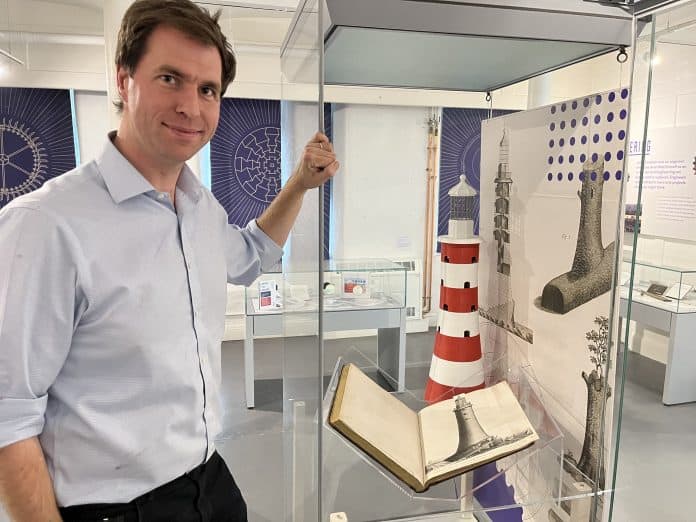An impressive, brick-by-brick recreation of John Smeaton’s famous Eddystone Lighthouse has gone on display in Armley alongside the 230-year-old designs which inspired it.
Civil Engineer and railway enthusiast Mark Calvert designed the model and then printed each part on a 3D printer, after an illuminating study into the famed Leeds-born engineer’s original masterwork.
Now his model has taken pride of place in an exhibition at Leeds Industrial Museum next to a stunning first edition book, penned by Smeaton himself, detailing his pioneering plans for the towering full-sized structure.
Coloured in the iconic red and white stripes which have become synonymous with the British seaside, the metre-high model is made up of scores of interlocking bricks, which mimic the huge granite blocks and dovetail joints of the full-sized version.
Mark, a former chair of the Yorkshire branch of the Institution of Civil Engineers, became fascinated by the intricacy of Smeaton’s plans, which were themselves inspired by the strong, sweeping appearance of an oak tree.
He said: “Smeaton’s lighthouse designs have always been fascinating, but it isn’t until you look at them in detail that you fully marvel at the incredible thought process which much have gone into their actual construction.
“Each individual block had to correspond exactly to the ones around, allowing them to interlock and make the lighthouse so strong and resilient against vast forces of the sea that had swept away the lighthouses that stood before Smeaton’s attempt.
“It was such a challenge to recreate these designs and a really proud moment to see my model on display alongside the designs which came from the mind of Smeaton himself.”
Born in Whitkirk, Leeds in 1724, self-taught engineer Smeaton was tasked with building a lighthouse to guide ships through the notoriously perilous passage through the Eddystone Rocks off the coast of Devon in around 1756.
Inspired by the tapered trunk of an oak tree and the kerbstones of London’s pavements, the completed lighthouse stood 59 feet high, and was first lit on October 16, 1759.
On loan from Leeds Central Library, the book of his designs itself took 35 years to complete and was dedicated by the author to King George III.
Both the book and Mark’s model are on display as part of Engineery: Building Better Futures, an exhibition exploring the story of civil engineering and the huge impact it has had on the world.
The exhibition is a collaboration between Leeds Museums and Galleries and Smeaton 300, a programme designed by local arts organisation Foxglove to mark Smeaton’s 300th birthday. Mark worked alongside Foxglove, who consulted him as an expert engineer as part of the programme.
For more information on Smeaton 300, visit: The Project – Smeaton300
For more details about Engineery, which is on now at Leeds Industrial Museum, please visit: Engineery – Leeds Museums & Galleries
Sponsored content


